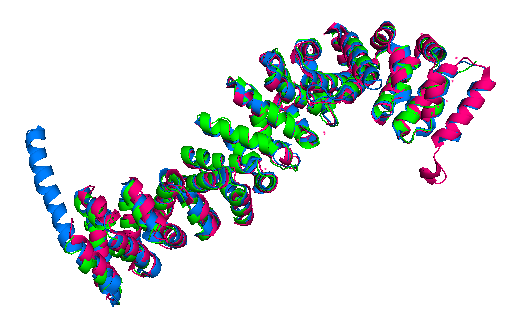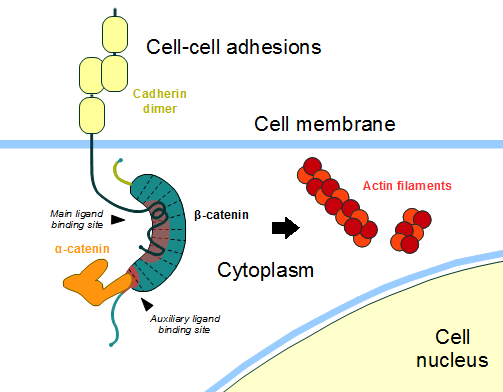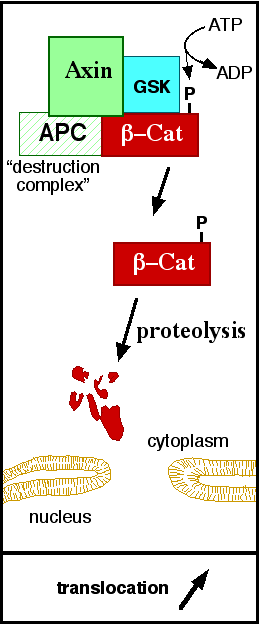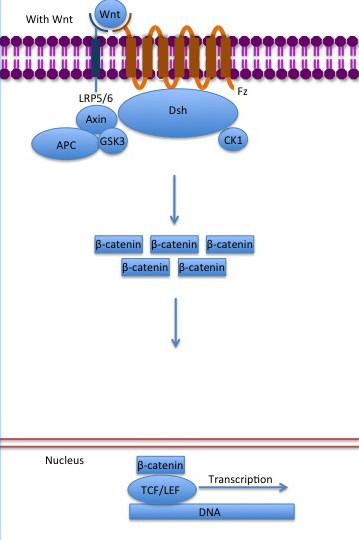User:Isabela Fonseca de Oliveira Granha/Sandbox 1
From Proteopedia
(Difference between revisions)
| Line 10: | Line 10: | ||
The terminal domains sequences mediate some of the protein interactions and are negatively charged. It is observed that the <scene name='84/848919/C-helix3correta/1'>helix-C constitutes the C-terminal domain</scene>. The N terminus of the first armadillo repeat has an <scene name='84/848919/Correton-terminushelix/1'>extra alpha helix</scene>. Both N- and C-terminal domains do not interact specifically with the armadillo repeat domain. <ref name="xing2009" /> | The terminal domains sequences mediate some of the protein interactions and are negatively charged. It is observed that the <scene name='84/848919/C-helix3correta/1'>helix-C constitutes the C-terminal domain</scene>. The N terminus of the first armadillo repeat has an <scene name='84/848919/Correton-terminushelix/1'>extra alpha helix</scene>. Both N- and C-terminal domains do not interact specifically with the armadillo repeat domain. <ref name="xing2009" /> | ||
| - | The armadillo domain is more conserved than the terminal domains. It is made of 12 armadillo repeats each one with <scene name='84/848919/Centerarm5_helices/1'>three alpha helices connected by loops</scene> (as shown in ARM repeat 5), except for the <scene name='84/848919/Centerarm_repeat_7/1'>ARM repeat 7, which has two helices</scene>. Furthermore, it has a particular site which is positively charged, constituting the | + | The armadillo domain is more conserved than the terminal domains. It is made of 12 armadillo repeats each one with <scene name='84/848919/Centerarm5_helices/1'>three alpha helices connected by loops</scene> (as shown in ARM repeat 5), except for the <scene name='84/848919/Centerarm_repeat_7/1'>ARM repeat 7, which has two helices</scene>. Furthermore, it has a particular site which is positively charged, constituting the binding surface for the majority of ß-catenin ligands. Because the armadillo domain is positively while the terminal tails are negatively charged, their interactions are nonspecific. It is proposed that both tails act like chaperones - they might avoid nonspecific protein interactions of the ARM repeat domain and its self-aggregation.<ref name="xing2009" /> |
In contrast to the armadillo ligand-binding structural groove, the C-terminal tail is highly negatively charged. The C-helix caps the {{Template:ColorKey_Hydrophobic}} <scene name='84/848919/Centerhydrophilichelixc/1'>surface formed by the C-terminal end of the last armadillo repeats</scene>. However, the other side of the surface, exposed to solvent, is composed of {{Template:ColorKey_Polar}} residues. Thereby, this structure forms part of the superhelical structure core of ß-catenin together with armadillo repeat domain. <ref name="xing2009" /> | In contrast to the armadillo ligand-binding structural groove, the C-terminal tail is highly negatively charged. The C-helix caps the {{Template:ColorKey_Hydrophobic}} <scene name='84/848919/Centerhydrophilichelixc/1'>surface formed by the C-terminal end of the last armadillo repeats</scene>. However, the other side of the surface, exposed to solvent, is composed of {{Template:ColorKey_Polar}} residues. Thereby, this structure forms part of the superhelical structure core of ß-catenin together with armadillo repeat domain. <ref name="xing2009" /> | ||
| Line 16: | Line 16: | ||
It is possible that the C-helix is important for the transactivation of Wnt-responsive genes, but not for the cell adhesion through [[Cadherin|cadherins]]. Hence, this same β-catenin region is also the binding site of transcriptional inhibitors that compete directly with TCF for β-catenin binding.<ref name="xing2009" /> | It is possible that the C-helix is important for the transactivation of Wnt-responsive genes, but not for the cell adhesion through [[Cadherin|cadherins]]. Hence, this same β-catenin region is also the binding site of transcriptional inhibitors that compete directly with TCF for β-catenin binding.<ref name="xing2009" /> | ||
| - | Finally, the ''Danio rerio'' (full length structure, blue), ''Mus musculus'' (armadillo repeat region, green) and ''Homo sapiens'' (full length structure, pink) beta-catenin alignment (Figure 1) shows that the protein structure is quite similar in these organisms. The three structures have 12 armadillo repeat group and the superposition indicates that the helix C in zebrafish and human beta-catenin conformation and orientation are essentially the same in both crystal structures. This great similarity between these proteins demonstrates that beta-catenin is evolutionary conserved and so are the pathways that it takes part. | + | Finally, the ''Danio rerio'' ([http://www.rcsb.org/structure/2Z6G 2Z6G] full length structure, blue), ''Mus musculus'' ([https://www.rcsb.org/structure/2BCT] armadillo repeat region, green) and ''Homo sapiens'' ([https://www.rcsb.org/structure/2Z6H] full length structure, pink) beta-catenin alignment (Figure 1) shows that the protein structure is quite similar in these organisms. The three structures have 12 armadillo repeat group and the superposition indicates that the helix C in zebrafish and human beta-catenin conformation and orientation are essentially the same in both crystal structures. This great similarity between these proteins demonstrates that beta-catenin is evolutionary conserved and so are the pathways that it takes part. |
[[Image:II2z6g 2bct 2z6h white.png]] | [[Image:II2z6g 2bct 2z6h white.png]] | ||
Revision as of 18:20, 10 August 2020
ß-catenin
ß-catenin is an important element in cell-cell adherens junctions, called cadherins. Reported in all Eukaryota (Eukaryota) phylum, in humans the gene CTNNB1 (CTNNB1) transcribes a 95kDa protein that allows cadherins to anchor in cytoeskeleton (actin filaments) by connecting cytoplasmic proteins. Besides that, it is an essential regulator of the canonical Wnt pathway [1] (related to embryonic development). Disturbance of this activity is associated with cancer and other diseases. Therefore, ß-catenin is an important target for developing medication for many diseases, with considerable interest in its structure. [2]
| |||||||||||




